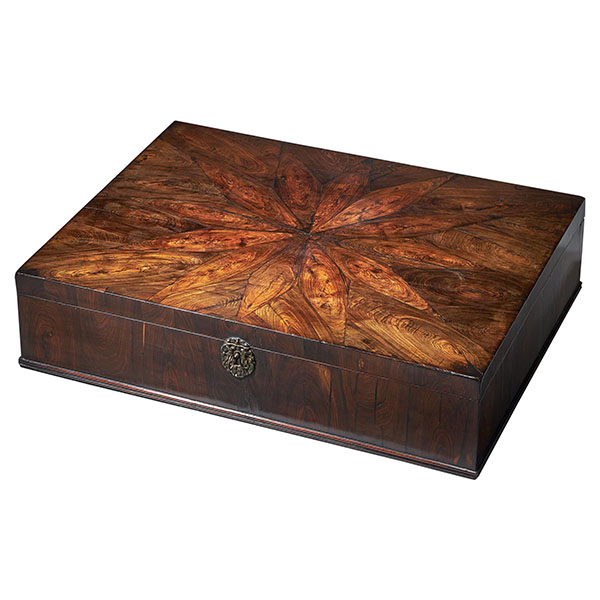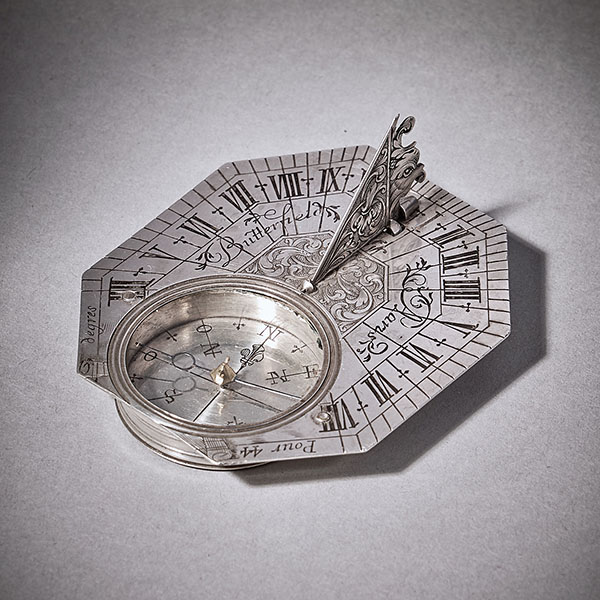19th-Century Carriage Clock signed Charles Frodsham, London
1870 London
SOLD
Request Information
Follow Us
19th-Century Carriage Clock signed Charles Frodsham, London
The so-called gorge case has its original gilding. It has bevelled glass panels on all sides so that the movement is entirely visible and is surmounted by a shaped carrying handle. The white enamel dial has a Roman chapter ring, with Arabic five-minute and minute divisions. It is signed and numbered by the maker in the following manner:
Chas. Frodsham & Co.
No 19964 Paris
The time is indicated by a pair of period blued-steel hands. The spring-driven, eight-day movement is
Features
• Eight-day movement
• Original silvered platform escapement
• Repeat button
• Original gilding
• Strike/silent function in the bottom
•
• Glazed all around
Dimensions:
• Height (handle up): 7” (17.5 cm)
Condition
Provenance
Literature
Dimensions
PREVIOUSLY SOLD

Important Charles II 17th Century Princes Wood and Marquetry Longcase Clock
Important Charles II 17th Century Princes Wood and Marquetry Longcase Clock SOLD Follow UsImportant Charles II 17th Century Princes Wood and Marquetry Longcase Clock A unique and important Charles II 17th century month-going Princes wood and...

17th Century Charles II Cocuswood Lace Box, Circa 1660, England
17th Century Charles II Cocuswood Lace Box, Circa 1660, England SoldFollow Us17th Century Charles II Cocuswood Lace Box, Circa 1660, England An extremely rare and important Cocuswood oyster (Brya ebenus) lace box from the reign of Charles II,...

A Rare And Unusual 19th-Century Carriage Clock Signed Devienne Lamy A St Quentin, Circa: 1860
A Rare And Unusual 19th-Century Carriage Clock Signed Devienne Lamy A St Quentin, circa 1860. The gorge case has bevelled glass panels on all sides.

A superb 17th-century olive oyster lace box from the reign of King Charles II, circa 1675-85.
A superb 17th century olive oyster lace box from the reign of King Charles II, circa 1675-85. Geometric patterns adorn the selected and book-matched hand cut olive oysters to the top which is beautifully inlaid with fine boxwood stringing, cross-banded and edged with cross grain mouldings, all in figured olive.

A Unique And Fine Mid 19th-Century Travelling Clock By Celebrated Makers Arnold & Dent, London
Unique and Fine Mid 19th-Century Travelling Clock By Celebrated Makers Arnold & Dent, London. The time is indicated by a fine pair of blued-steel Breguet hands.

A fine burr walnut George I dressing mirror. Circa 1715-25 England.
A fine burr walnut George I dressing mirror Circa 1715-25 England. SoldFollow UsA fine burr walnut George I antique dressing mirror An extremely rare and fine George I burr walnut dressing mirror raised on ball and bracket feet. The drawer...

Important Charles II 17th Century Princes Wood and Marquetry Longcase Clock
Important Charles II 17th Century Princes Wood and Marquetry Longcase Clock SOLD Follow UsImportant Charles II 17th Century Princes Wood and Marquetry Longcase Clock A unique and important Charles II 17th century month-going Princes wood and...

17th Century Charles II Cocuswood Lace Box, Circa 1660, England
17th Century Charles II Cocuswood Lace Box, Circa 1660, England SoldFollow Us17th Century Charles II Cocuswood Lace Box, Circa 1660, England An extremely rare and important Cocuswood oyster (Brya ebenus) lace box from the reign of Charles II,...

A Rare And Unusual 19th-Century Carriage Clock Signed Devienne Lamy A St Quentin, Circa: 1860
A Rare And Unusual 19th-Century Carriage Clock Signed Devienne Lamy A St Quentin, circa 1860. The gorge case has bevelled glass panels on all sides.

A superb 17th-century olive oyster lace box from the reign of King Charles II, circa 1675-85.
A superb 17th century olive oyster lace box from the reign of King Charles II, circa 1675-85. Geometric patterns adorn the selected and book-matched hand cut olive oysters to the top which is beautifully inlaid with fine boxwood stringing, cross-banded and edged with cross grain mouldings, all in figured olive.

A Unique And Fine Mid 19th-Century Travelling Clock By Celebrated Makers Arnold & Dent, London
Unique and Fine Mid 19th-Century Travelling Clock By Celebrated Makers Arnold & Dent, London. The time is indicated by a fine pair of blued-steel Breguet hands.

A fine burr walnut George I dressing mirror. Circa 1715-25 England.
A fine burr walnut George I dressing mirror Circa 1715-25 England. SoldFollow UsA fine burr walnut George I antique dressing mirror An extremely rare and fine George I burr walnut dressing mirror raised on ball and bracket feet. The drawer...
YOU MAY ALSO LIKE

Rare Silver Pocket Sundial and Compass by Michael Butterfield, Paris, circa 1700
Rare Silver Pocket Sundial and Compass by Michael Butterfield, Paris, circa 1700 £4,900 Follow UsRare Silver Pocket Sundial and Compass by Michael Butterfield, Paris, circa 1700 A beautiful, rare solid silver Anglo-French octagonal pocket...

Engraved Eight-Day Striking and Repeating Carriage Clock by Perregaux Au Locle
Engraved Eight-Day Striking and Repeating Carriage Clock by Perregaux Au Locle Follow UsEngraved Eight-Day Striking and Repeating Carriage Clock by Perregaux Au Locle The superb engraved gilt gorge brass case has facetted glass panels to all...

Fine George III 18th Century Period Mahogany Longcase Clock by Tomas Fowle
18th Century Period Mahogany Longcase Clock by Tomas Fowle £12,995 Follow Us18th Century Period Mahogany Longcase Clock by Tomas Fowle A fine George III period mahogany longcase clock of excellent colour, patination and proportions, circa...

17th Century Figured Walnut and Seaweed Marquetry Lace Box
17th Century Figured Walnut and Seaweed Marquetry Lace Box £3,600 Follow Us17th Century Figured Walnut and Seaweed Marquetry Lace Box A fine and extremely rare figured walnut and seaweed marquetry 'lace box', circa.... let’s break it down -...

19th Century Repeating Gilt-Brass Carriage Clock by the Famous Drocourt
19th Century Repeating Gilt-Brass Carriage Clock by the Famous Drocourt £5,600 Follow Us19th Century Repeating Gilt-Brass Carriage Clock by the Famous Drocourt A superb repeating carriage clock with a gilt-brass gorge case by the famous maker...

17th-Century Hague Clock Signed by Pieter Visbagh, circa 1675
Small 17th Century Hague clock made c. 1675 by Pieter Visbagh, who was apprenticed by Salomon Coster. The latter made the first pendulum clock according to the instructions of Christiaan Huygens, the internationally renowned scientist who developed the idea of applying a pendulum to a clock movement.

Rare Silver Pocket Sundial and Compass by Michael Butterfield, Paris, circa 1700
Rare Silver Pocket Sundial and Compass by Michael Butterfield, Paris, circa 1700 £4,900 Follow UsRare Silver Pocket Sundial and Compass by Michael Butterfield, Paris, circa 1700 A beautiful, rare solid silver Anglo-French octagonal pocket...

Engraved Eight-Day Striking and Repeating Carriage Clock by Perregaux Au Locle
Engraved Eight-Day Striking and Repeating Carriage Clock by Perregaux Au Locle Follow UsEngraved Eight-Day Striking and Repeating Carriage Clock by Perregaux Au Locle The superb engraved gilt gorge brass case has facetted glass panels to all...

Fine George III 18th Century Period Mahogany Longcase Clock by Tomas Fowle
18th Century Period Mahogany Longcase Clock by Tomas Fowle £12,995 Follow Us18th Century Period Mahogany Longcase Clock by Tomas Fowle A fine George III period mahogany longcase clock of excellent colour, patination and proportions, circa...

17th Century Figured Walnut and Seaweed Marquetry Lace Box
17th Century Figured Walnut and Seaweed Marquetry Lace Box £3,600 Follow Us17th Century Figured Walnut and Seaweed Marquetry Lace Box A fine and extremely rare figured walnut and seaweed marquetry 'lace box', circa.... let’s break it down -...

19th Century Repeating Gilt-Brass Carriage Clock by the Famous Drocourt
19th Century Repeating Gilt-Brass Carriage Clock by the Famous Drocourt £5,600 Follow Us19th Century Repeating Gilt-Brass Carriage Clock by the Famous Drocourt A superb repeating carriage clock with a gilt-brass gorge case by the famous maker...

17th-Century Hague Clock Signed by Pieter Visbagh, circa 1675
Small 17th Century Hague clock made c. 1675 by Pieter Visbagh, who was apprenticed by Salomon Coster. The latter made the first pendulum clock according to the instructions of Christiaan Huygens, the internationally renowned scientist who developed the idea of applying a pendulum to a clock movement.








